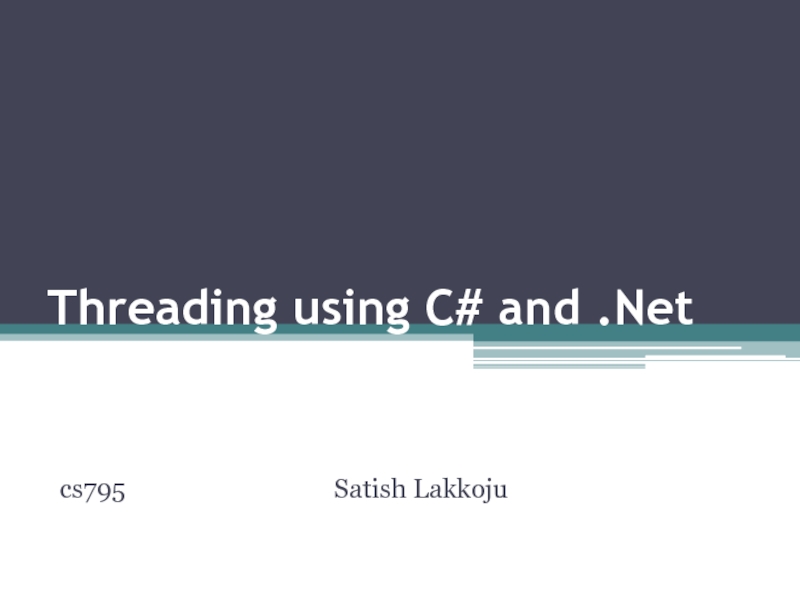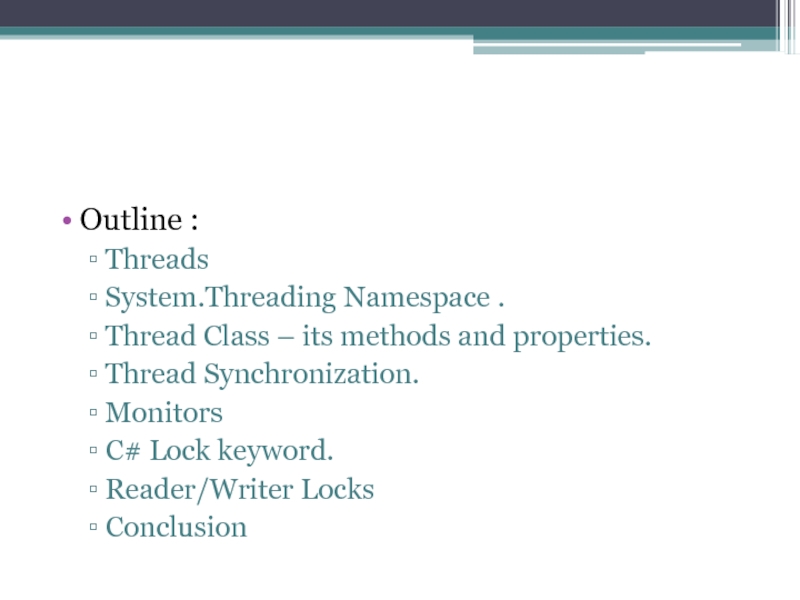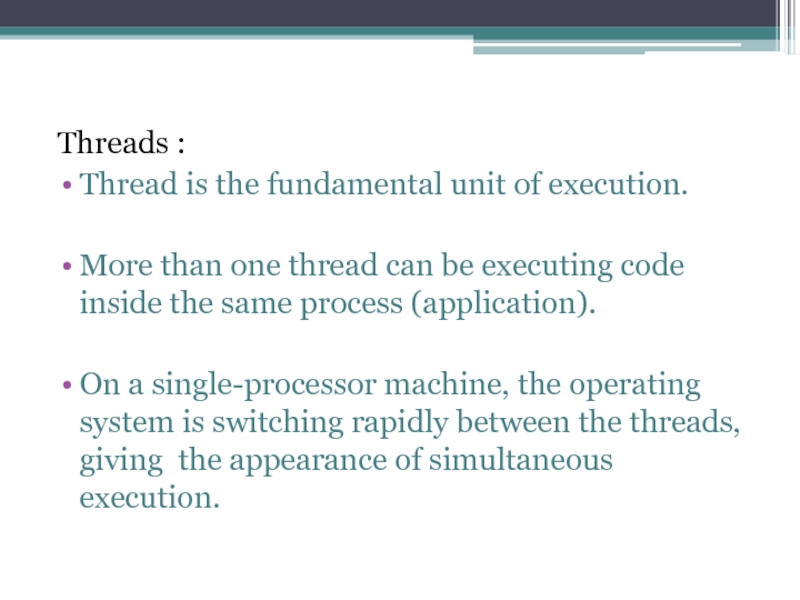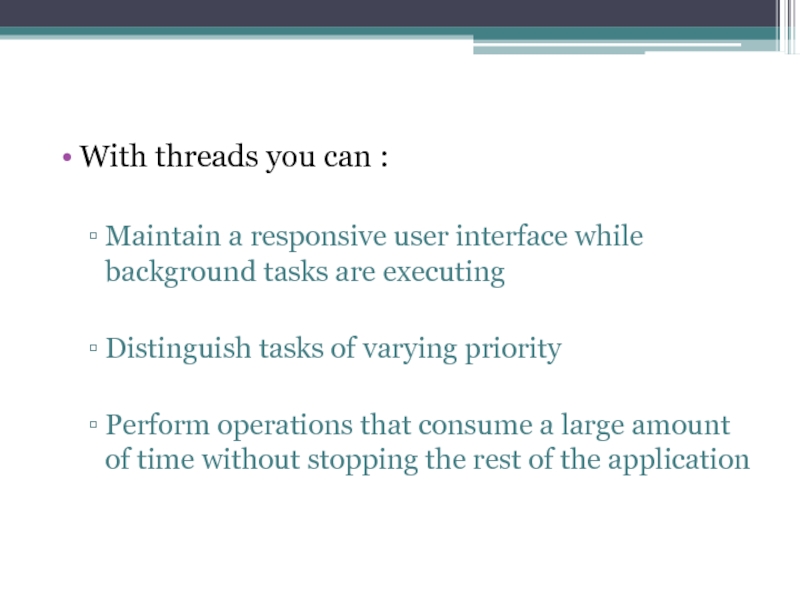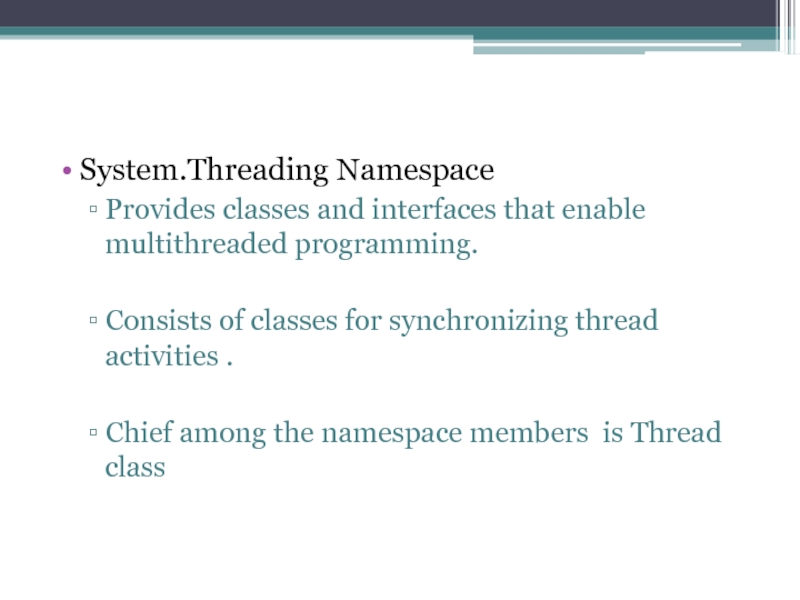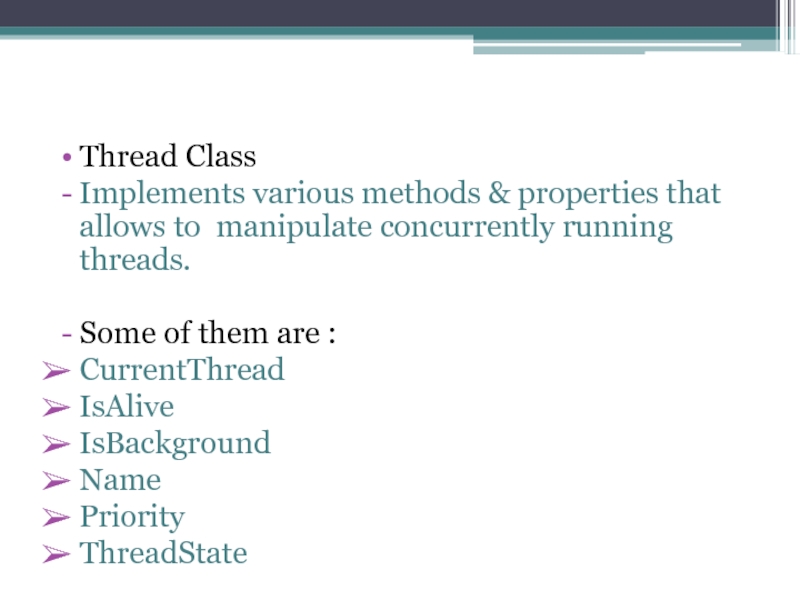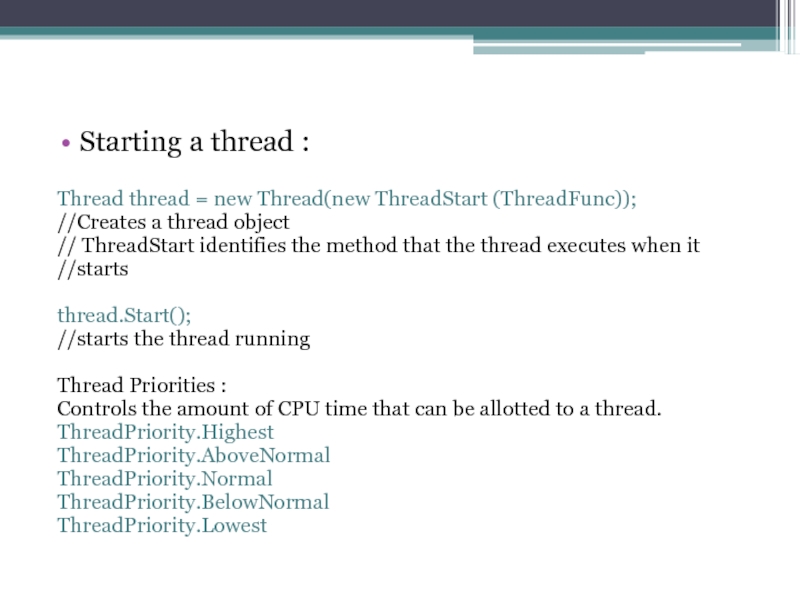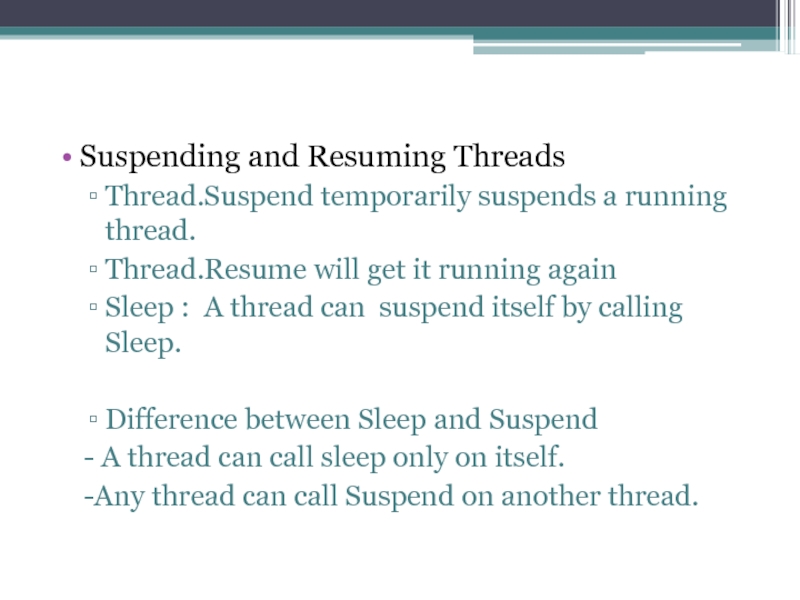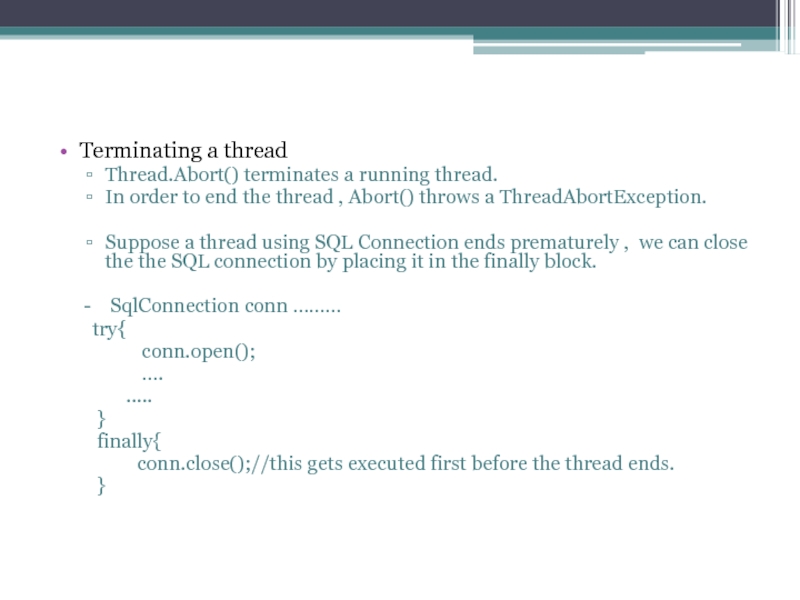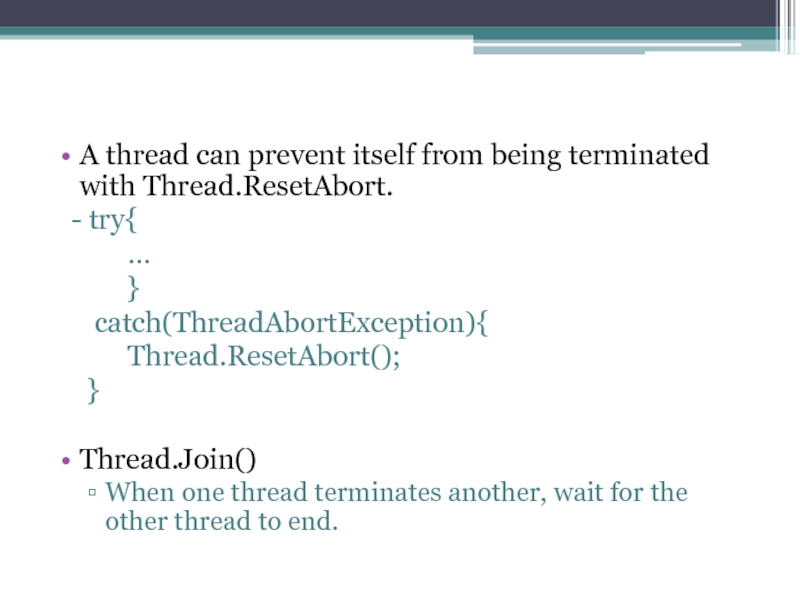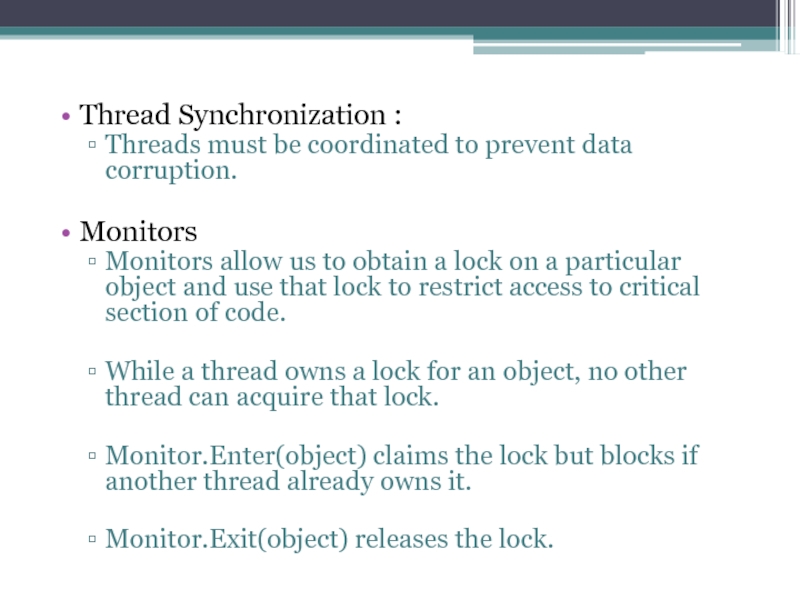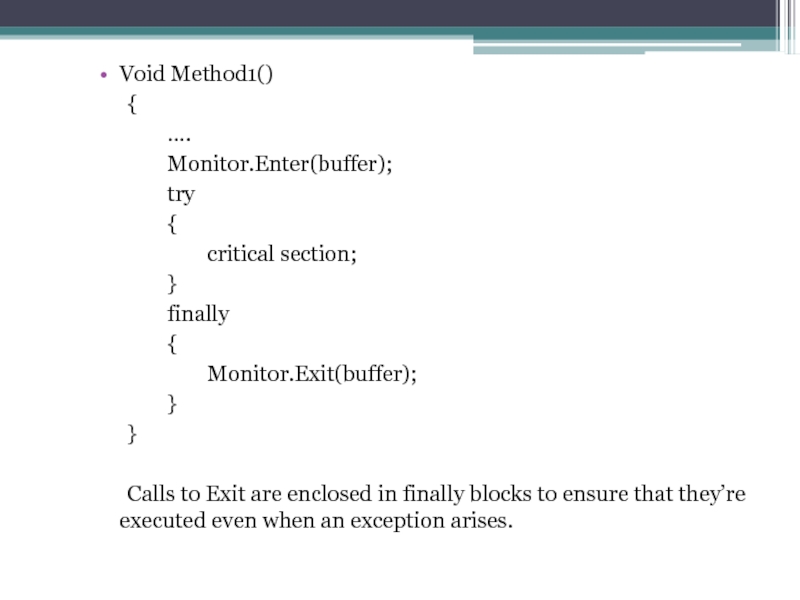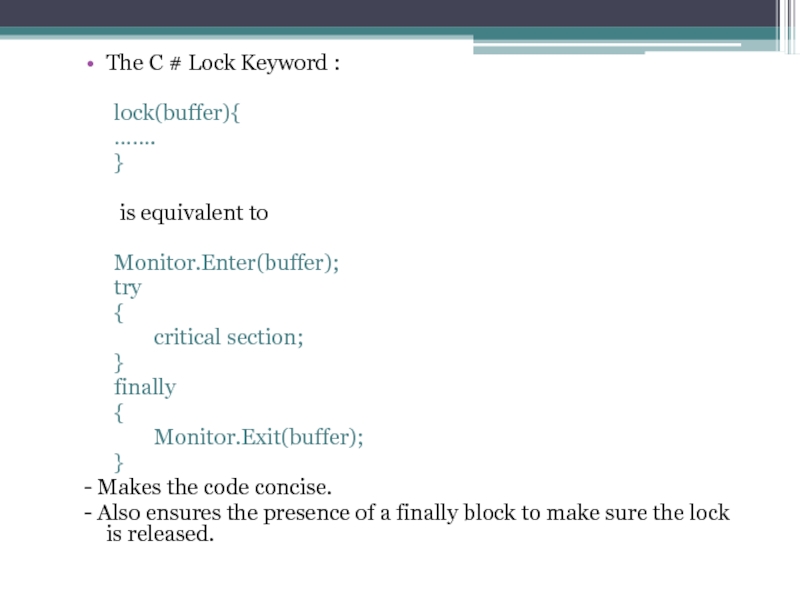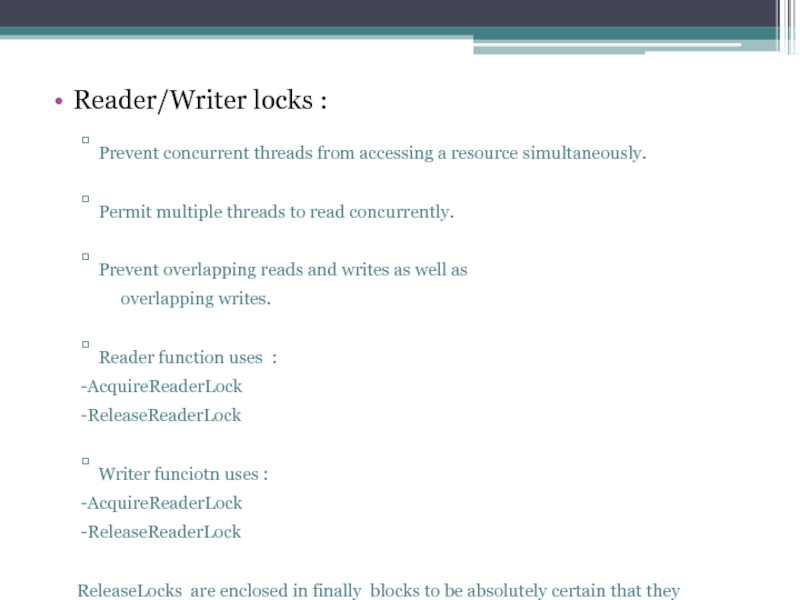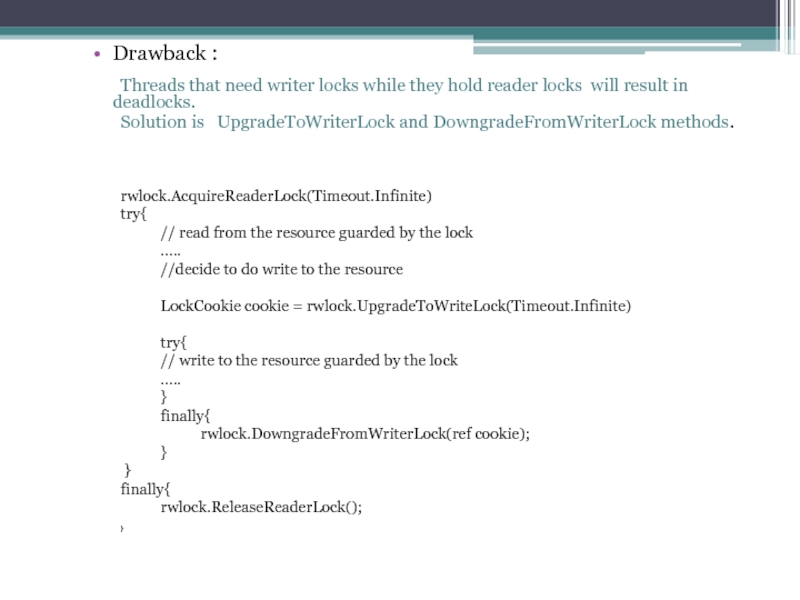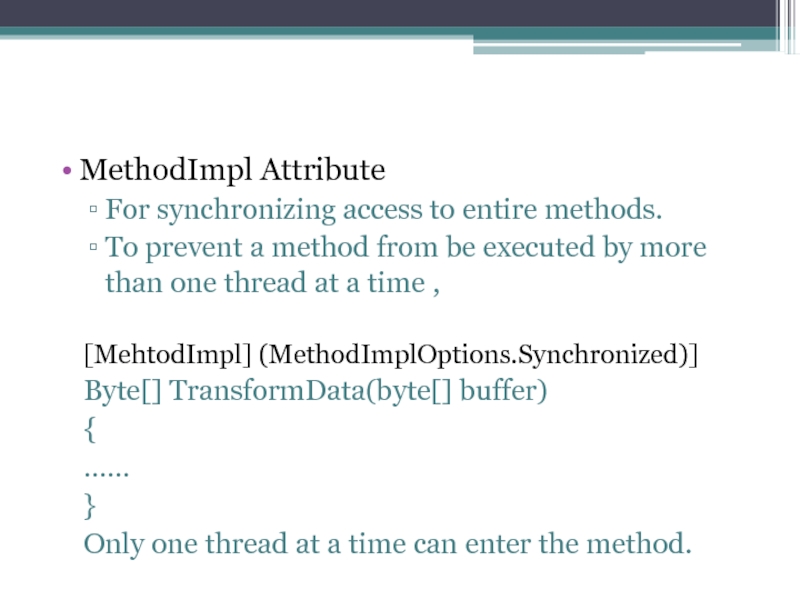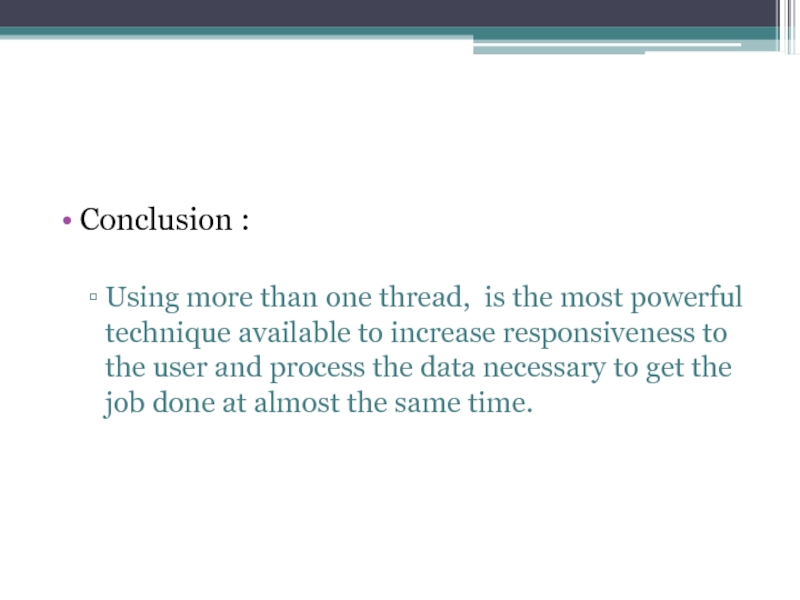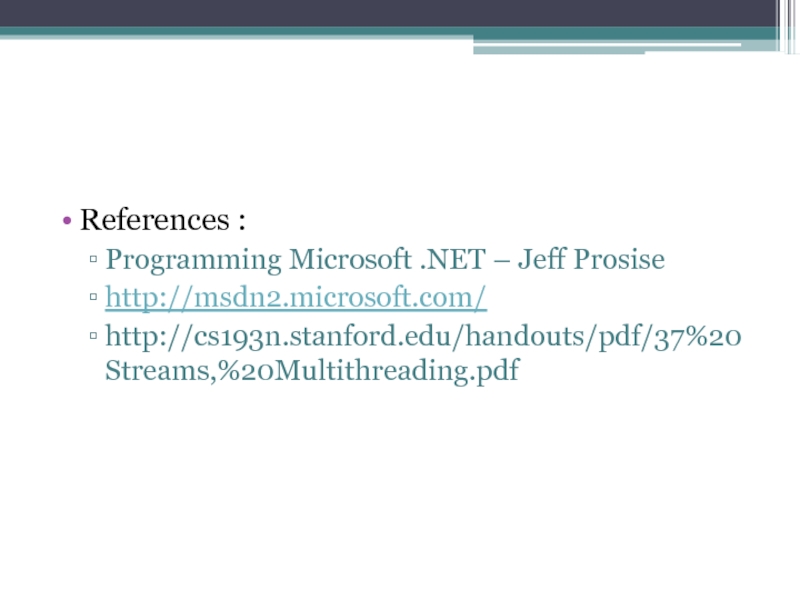- Главная
- Разное
- Дизайн
- Бизнес и предпринимательство
- Аналитика
- Образование
- Развлечения
- Красота и здоровье
- Финансы
- Государство
- Путешествия
- Спорт
- Недвижимость
- Армия
- Графика
- Культурология
- Еда и кулинария
- Лингвистика
- Английский язык
- Астрономия
- Алгебра
- Биология
- География
- Детские презентации
- Информатика
- История
- Литература
- Маркетинг
- Математика
- Медицина
- Менеджмент
- Музыка
- МХК
- Немецкий язык
- ОБЖ
- Обществознание
- Окружающий мир
- Педагогика
- Русский язык
- Технология
- Физика
- Философия
- Химия
- Шаблоны, картинки для презентаций
- Экология
- Экономика
- Юриспруденция
Threading using C# and.Net презентация
Содержание
- 1. Threading using C# and.Net
- 2. Outline : Threads System.Threading Namespace
- 3. Threads : Thread is the
- 4. With threads you can :
- 5. System.Threading Namespace Provides classes and
- 6. Thread Class Implements various methods
- 7. Starting a thread :
- 8. Suspending and Resuming Threads Thread.Suspend
- 9. Terminating a thread Thread.Abort()
- 10. A thread can prevent itself
- 11. Thread Synchronization : Threads must be coordinated
- 12. Void Method1() {
- 13. The C # Lock
- 14. Reader/Writer locks : Prevent
- 15. Drawback :
- 16. MethodImpl Attribute For synchronizing
- 17. Conclusion : Using more
- 18. References : Programming Microsoft .NET – Jeff Prosise http://msdn2.microsoft.com/ http://cs193n.stanford.edu/handouts/pdf/37%20Streams,%20Multithreading.pdf
Слайд 2
Outline :
Threads
System.Threading Namespace .
Thread Class – its methods and properties.
Thread
Synchronization.
Monitors
C# Lock keyword.
Reader/Writer Locks
Conclusion
Monitors
C# Lock keyword.
Reader/Writer Locks
Conclusion
Слайд 3
Threads :
Thread is the fundamental unit of execution.
More than one
thread can be executing code inside the same process (application).
On a single-processor machine, the operating system is switching rapidly between the threads, giving the appearance of simultaneous execution.
On a single-processor machine, the operating system is switching rapidly between the threads, giving the appearance of simultaneous execution.
Слайд 4
With threads you can :
Maintain a responsive user interface while
background tasks are executing
Distinguish tasks of varying priority
Perform operations that consume a large amount of time without stopping the rest of the application
Distinguish tasks of varying priority
Perform operations that consume a large amount of time without stopping the rest of the application
Слайд 5
System.Threading Namespace
Provides classes and interfaces that enable multithreaded programming.
Consists of
classes for synchronizing thread activities .
Chief among the namespace members is Thread class
Chief among the namespace members is Thread class
Слайд 6
Thread Class
Implements various methods & properties that allows to manipulate
concurrently running threads.
Some of them are :
CurrentThread
IsAlive
IsBackground
Name
Priority
ThreadState
Some of them are :
CurrentThread
IsAlive
IsBackground
Name
Priority
ThreadState
Слайд 7
Starting a thread :
Thread thread = new Thread(new ThreadStart (ThreadFunc));
//Creates
a thread object
// ThreadStart identifies the method that the thread executes when it
//starts
thread.Start();
//starts the thread running
Thread Priorities :
Controls the amount of CPU time that can be allotted to a thread.
ThreadPriority.Highest
ThreadPriority.AboveNormal
ThreadPriority.Normal
ThreadPriority.BelowNormal
ThreadPriority.Lowest
// ThreadStart identifies the method that the thread executes when it
//starts
thread.Start();
//starts the thread running
Thread Priorities :
Controls the amount of CPU time that can be allotted to a thread.
ThreadPriority.Highest
ThreadPriority.AboveNormal
ThreadPriority.Normal
ThreadPriority.BelowNormal
ThreadPriority.Lowest
Слайд 8
Suspending and Resuming Threads
Thread.Suspend temporarily suspends a running thread.
Thread.Resume will
get it running again
Sleep : A thread can suspend itself by calling Sleep.
Difference between Sleep and Suspend
- A thread can call sleep only on itself.
-Any thread can call Suspend on another thread.
Sleep : A thread can suspend itself by calling Sleep.
Difference between Sleep and Suspend
- A thread can call sleep only on itself.
-Any thread can call Suspend on another thread.
Слайд 9
Terminating a thread
Thread.Abort() terminates a running thread.
In order to
end the thread , Abort() throws a ThreadAbortException.
Suppose a thread using SQL Connection ends prematurely , we can close the the SQL connection by placing it in the finally block.
- SqlConnection conn ………
try{
conn.open();
….
.....
}
finally{
conn.close();//this gets executed first before the thread ends.
}
Suppose a thread using SQL Connection ends prematurely , we can close the the SQL connection by placing it in the finally block.
- SqlConnection conn ………
try{
conn.open();
….
.....
}
finally{
conn.close();//this gets executed first before the thread ends.
}
Слайд 10
A thread can prevent itself from being terminated with Thread.ResetAbort.
- try{
…
}
catch(ThreadAbortException){
Thread.ResetAbort();
}
Thread.Join()
When one thread terminates another, wait for the other thread to end.
…
}
catch(ThreadAbortException){
Thread.ResetAbort();
}
Thread.Join()
When one thread terminates another, wait for the other thread to end.
Слайд 11Thread Synchronization :
Threads must be coordinated to prevent data corruption.
Monitors
Monitors
allow us to obtain a lock on a particular object and use that lock to restrict access to critical section of code.
While a thread owns a lock for an object, no other thread can acquire that lock.
Monitor.Enter(object) claims the lock but blocks if another thread already owns it.
Monitor.Exit(object) releases the lock.
While a thread owns a lock for an object, no other thread can acquire that lock.
Monitor.Enter(object) claims the lock but blocks if another thread already owns it.
Monitor.Exit(object) releases the lock.
Слайд 12
Void Method1()
{
….
Monitor.Enter(buffer);
try
{
critical section;
}
finally
{
Monitor.Exit(buffer);
}
}
Calls to Exit are enclosed in finally
blocks to ensure that they’re executed even when an exception arises.
Слайд 13
The C # Lock Keyword :
lock(buffer){
…….
}
is equivalent to
Monitor.Enter(buffer);
try
{
critical section;
}
finally
{
Monitor.Exit(buffer);
}
- Makes the code concise.
- Also ensures the presence of a finally block to make sure the lock is released.
Слайд 14
Reader/Writer locks :
Prevent concurrent threads from accessing a resource simultaneously.
Permit
multiple threads to read concurrently.
Prevent overlapping reads and writes as well as
overlapping writes.
Reader function uses :
-AcquireReaderLock
-ReleaseReaderLock
Writer funciotn uses :
-AcquireReaderLock
-ReleaseReaderLock
ReleaseLocks are enclosed in finally blocks to be absolutely certain that they are executed
Prevent overlapping reads and writes as well as
overlapping writes.
Reader function uses :
-AcquireReaderLock
-ReleaseReaderLock
Writer funciotn uses :
-AcquireReaderLock
-ReleaseReaderLock
ReleaseLocks are enclosed in finally blocks to be absolutely certain that they are executed
Слайд 15
Drawback :
Threads that need writer locks while they hold
reader locks will result in deadlocks.
Solution is UpgradeToWriterLock and DowngradeFromWriterLock methods.
rwlock.AcquireReaderLock(Timeout.Infinite)
try{
// read from the resource guarded by the lock
…..
//decide to do write to the resource
LockCookie cookie = rwlock.UpgradeToWriteLock(Timeout.Infinite)
try{
// write to the resource guarded by the lock
…..
}
finally{
rwlock.DowngradeFromWriterLock(ref cookie);
}
}
finally{
rwlock.ReleaseReaderLock();
}
Solution is UpgradeToWriterLock and DowngradeFromWriterLock methods.
rwlock.AcquireReaderLock(Timeout.Infinite)
try{
// read from the resource guarded by the lock
…..
//decide to do write to the resource
LockCookie cookie = rwlock.UpgradeToWriteLock(Timeout.Infinite)
try{
// write to the resource guarded by the lock
…..
}
finally{
rwlock.DowngradeFromWriterLock(ref cookie);
}
}
finally{
rwlock.ReleaseReaderLock();
}
Слайд 16
MethodImpl Attribute
For synchronizing access to entire methods.
To prevent a
method from be executed by more than one thread at a time ,
[MehtodImpl] (MethodImplOptions.Synchronized)]
Byte[] TransformData(byte[] buffer)
{
……
}
Only one thread at a time can enter the method.
[MehtodImpl] (MethodImplOptions.Synchronized)]
Byte[] TransformData(byte[] buffer)
{
……
}
Only one thread at a time can enter the method.
Слайд 17
Conclusion :
Using more than one thread, is the most powerful
technique available to increase responsiveness to the user and process the data necessary to get the job done at almost the same time.
